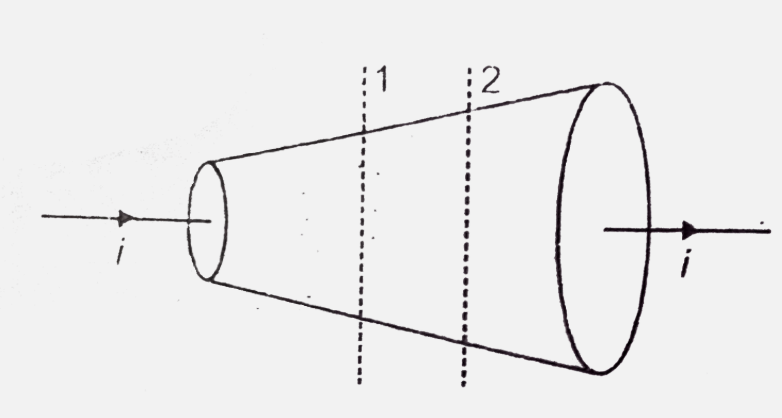Current I is following through a wire of non-uniform cross-section as shown. Match the following columns.

Column IColumn II(A)Current density(p)More at section 1 than 2(B)Electric field(q)More at section 2 than 1(C)Resistance per unit length(r)Same at both section 1 and 2 (D)Potential difference per unit length(s)Data insufficient
The correct Answer is:A(p), B(p),C(p), D(p)
Step by step video & image solution for Current I is following through a wire of non-uniform cross-section as shown. Match the following columns. {:(,"Column I",,"Column II"),((A),"Current density",(p),"More at section 1 than 2"),((B),"Electric field",(q),"More at section 2 than 1"),((C ) , "Resistance per unit length",(r ),"Same at both section 1 and 2 "),((D ), "Potential difference per unit length",(s),"Data insufficient"):} by Physics experts to help you in doubts & scoring excellent marks in Class 12 exams.
Updated on:21/07/2023Topper's Solved these Questions
- CURRENT ELECTRICITYBOOK - AAKASH INSTITUTECHAPTER - CURRENT ELECTRICITYEXERCISE - ASSIGNMENT SECTION-H( INTEGER ANSWER TYPE QUESTIONS)
3 Videos
- CURRENT ELECTRICITYBOOK - AAKASH INSTITUTECHAPTER - CURRENT ELECTRICITYEXERCISE - ASSIGNMENT SECTION-H ( MULTIPLE TRUE-FALE TYPE QUESTIONS)
5 Videos
- CURRENT ELECTRICITYBOOK - AAKASH INSTITUTECHAPTER - CURRENT ELECTRICITYEXERCISE - ASSIGNMENT SECTION-E (ASSERTION-REASON TYPE QUESTION)
13 Videos
- COMMUNICATION SYSTEMS BOOK - AAKASH INSTITUTECHAPTER - COMMUNICATION SYSTEMS EXERCISE - ASSIGNMENT SECTION D (Assertion-Reason)
10 Videos
- DUAL NATURE OF RADIATION AND MATTER BOOK - AAKASH INSTITUTECHAPTER - DUAL NATURE OF RADIATION AND MATTER EXERCISE - ASSIGNMENT (SECTION-D)
10 Videos
Similar Questions
Current is flowing through a wire of non-uniform cross section. Cross section of wire at A is les than the cross section of wire at B. Then match the following

View SolutionMatch the following
Column-IColumn-II(A)unit of length in F.P.S(p)m(B)unit of mass in C.G.S(q)foot(C)unit of time(r)metre(s)gm(t)second
View Solution
Knowledge Check

Assertion : Current I is flowing through a cylindrical wire of non-uniform cross-section as shown. Section of wire near A will be more heated compared to the section near B.
Reason : Current density near A is more.AIf both Assertion and Reason are true and the Reason is correct explanation of the Assertion.BIf both Assertion and Reason are true but Reason is not the correct explanation of Assertion.CIf Assertion is true, but the Reason is false.DIf Assertion is false but the Reason is true.Assertion : If a current is flowing through a conducting wire of non-uniform cross-section, drift speed and resistance both will increase at a section where cross-sectional area is less.
Reason : Current density at such sections is more where cross-sectional area is less.AIf both Assertion and Reason are true and Reason is the correct explanation of Assertion.BIf both Assertion and Reason are true and Reason is not correct explanation of Assertion.CIf Assertion is true but Reason is false.DIf Assertion is false but Reason is true.
In the diagram shown in figure, match the following columns (take g=10ms−2)

Column IColumn II(A) Normal reaction(p) 12 SI unit(B) Force of friction(q) 20 SI unit(C) Acceleration of block(r) zero(s) 2 SI unit
View SolutionMatch the following.
Column AColumn B(A)Area/length( )(a)metre−1(B)Mass/volume( )(b)No unit(C)Length/area( )(c)metre(D)Length2/area( )(d)kg m−3
View SolutionMatch the following
Column-IColumn-II(A)Derived unit(p)Height(B)Fundamental unit(q)Thickness(C)Derived quantity(r)Area(D)Fundamental quantity(s)Newton(t)Kilogram
View SolutionThree rods of equal length of same material are joined to form an equivalent triangle ABC as shown figure. Area of cross-section of rod AB is S of rod BC is 2S and that of AC is S , then
_E01_150_Q01.png)
Column-IColumn-II(A)Temperature of junctionB(p)Greater than50∘C(B)Heat current inAB(q)Less than50∘C(C)Heat current in BC(r)Is equal to current in BC(s)Is 23times heat current in AC(t)None
View SolutionColumn IColumn II(a)Work(p)WF(b)Kinetic energy(q)mgh(c)Potential energy(r)12mv2(d)Displacement(s)F×S
View SolutionMatch the following columns.
Column IColumn IIA.Teslap[ML2A−2T−2]B.Weberq[MLA−2T−1]C.Weber m−2q.[MA−1T−2]D.Henrys.None
View Solution